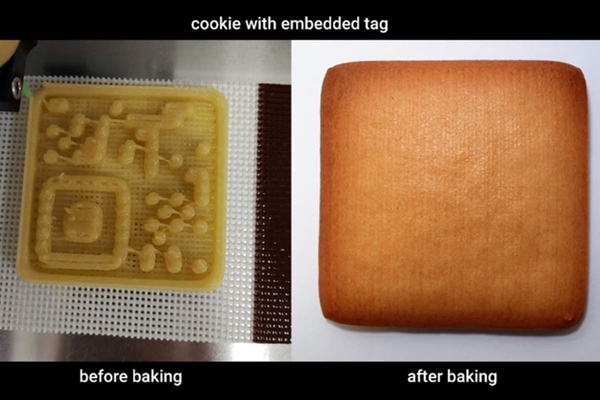Researchers at Osaka University in Japan have developed a way to embed an inconspicuous edible label into food that can be read without first destroying the food
Oct. 22, 2022 - Researchers at Osaka University in Japan have developed a way to embed an unobtrusive edible label into food that can be read without first damaging the food, the eurekalert website has learned. Another major advantage of the method is that the label does not change the appearance or flavor of the food at all, the researchers said.

△ Left, edible data embedded in food with a 3D printer. Image source: eurekalert.com
The technology is called "interiqr" (or "internal QR") and was developed by a team of researchers at Osaka University in Japan. As a proof of concept, the researchers recently 3D printed cookies that are smooth and look like ordinary cookies, but have a QR code pattern made up of gaps inside.

Labels containing data are commonly used in the food industry. They range from simple fruit stickers to radio frequency tags that use electromagnetic fields to automatically identify and track products. However, as people try to reduce additional packaging, scientists are racing to develop edible food labels that are essentially non-toxic and do not alter the taste or appearance of the food, while also being readable without damaging the food itself. Many foods can now be produced using 3D printers, explained Yamato Miyatake, the study's lead author. "We realized that the inside of edible objects such as cookies can be printed out to contain patterns of blank space so that when you shine light from the back of the cookie, the QR code becomes visible and can be read by a cell phone."
By using a QR code made from the cookie itself as a label, all the information is contained inside the cookie, so the appearance of the cookie remains completely intact. And because the QR code can be made visible using a simple backlight, the information is readily available to manufacturers, retailers and consumers at any stage of the cookie's journey from factory to consumption. Obviously, for now the technology will be limited to relatively thin, somewhat translucent 3D printed food products. Nevertheless, scientists hope it will eventually provide manufacturers, retailers and consumers with an alternative to more wasteful and expensive methods, such as paper labels routinely applied to fruit, or RFID tags applied to packaging. If information such as ingredients and nutritional content can be relayed by the food itself, then less packaging can be used.
According to the researchers, this 3D printing method is a good example of the digital transformation of food that will improve traceability and safety of food. The technology could also be used to provide novel food experiences through augmented reality, an exciting new frontier in the food industry. This new approach to embedding edible information in food is also important for reducing waste, and widespread adoption of these technologies promises to pave the way for a cleaner future.



